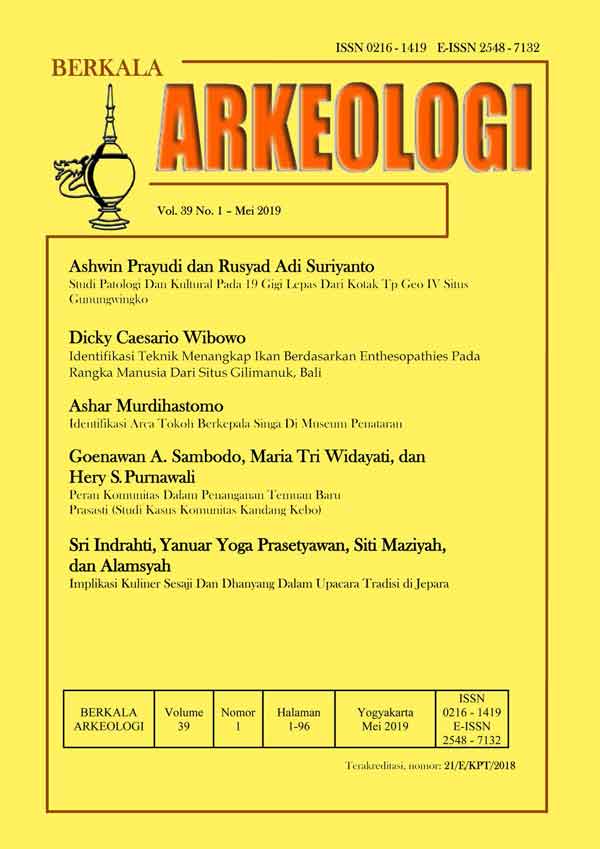IDENTIFIKASI ARCA TOKOH BERKEPALA SINGA DI MUSEUM PENATARAN
Main Article Content
Abstract
The field study that was organized by the committee of Premodern Java Summer Programme in 2016 targeted several museums in East Java, especially in Mojokerto-Penataran area. That field study was intended to provide an understanding about the development of cultural arts during the end of Hindu-Buddhist period of Majapahit Kingdom. This paper is discussing about one of the objects that was being observed during that Summer Programme. The object of discussion is the lion-headed figure, stored in Museum Penataran. During the Summer Programme, some participants have predicted that the statue is Lord Vishnu in his Narasimha form. That prediction was mainly based on the statue's head which resemble a lion's head. Through several studies, such as the description of the statue, the literature study of iconography, and analysis about the special iconographic character, this paper concluded that this figure is a manifestation of Ganesha, named Simha-Ganapati. The worship of Simha-Ganapati has a purpose not only to bring strength and courage, but also to provide confidence in facing problems by destroying all forms of negative thoughts.
Article Details

This work is licensed under a Creative Commons Attribution-NonCommercial-ShareAlike 4.0 International License.
References
Agoramoorthy, Govindasamy; Hsu, M. J. (2012). The Significance of Cows in India Society between Sacredness and Economy. Antropological Notebooks, 18(3), 5–12.
Ball, K. M. (2004). Animal Motifs in Asian Art: An Illustrated Guide to Their Meanings and Aesthetics. New York: Dover Publications, Inc.
BPCB Jateng, 2017. Mengulik Belalai Arca Ganesha. Diunduh dari https://kebudayaan.kemdikbud.go.id/bpcbjateng/mengulik-belalai-arca-ganesha/.
Buhnemann, G. (1955). Tantric Forms of GaņeÅ›a: According to the VidyÄrņavatantra. New Delhi: D.K. Printworld (P) Ltd.
Chandrika, V. S. (2007). Analytical Study of the Musical Compositions in Praise of Lord Ganapati. University of Kerala.
Chinmayananda, S. (1986). Glory og Ganesha. Bombay: Central Chinmaya Mission Trust.
Choskyi, J. (1988). Symbolism of Animals in Buddhism. Buddhist Himalaya I (I). tanpa halaman. Diunduh dari http://buddhim.20m.com/1-7.htm
Choskyi, V. J. (1988). Symbolism of Animals in Buddhism. BUddhist Himalaya, I(I).
Deka, D. (2010). Evolution of the Cult of Ganesa in Ancient and Medieval Assam. Universoty of Gaumati.
Geer, A. van der. (2008). Animals in Stone: Indian Mammals Sculptured Through Time. Leiden: Koninklijke Brill NV.
Gupte, R. S. (1972). Iconography of the Hindus, Buddhists, and Jains. Bombay: D.B. Taraporevala Sons & Co. Private Ltd.
Hadiyanta, Eka; Romawati, Sri Muryantini; Tanzaq, Y. (2014). Katalog Koleksi Arca Batu. (E. Astuti, Wahyu; Hadiyanta, Ed.). Yogyakarta: Balai Pelestarian Cagar Budaya Yogyakarta.
Haryono, T. (1980). Singa dalam Kesenian Hindu di Jawa Tengah. Berkala Arkeologi, 1(1), 42–51. https://doi.org/10.30883/jba.v1i1.275
Jouveau-Dubreuil, G. (1937). Iconography of Southern India. Paris: Librairie Orientaliste Paul Geuthner.
Khosravifard, Sam; Niamir, A. (2016). The Lair of the Lion in Iran. Cats in Iran Special Issue. Bern.
Kouli, D. R. (2012). Art and Iconography of the Sculpture of Kamrup District of Assam (From the 5th Century A.D. to the 18th Century A.D.). Gauhati University.
Kumaran, T. S. (tanpa tahun). Ganesha. E-book. Diunduh dari http://cincinnatitemple.com/wp-content/uploads/images/pdf/Ganesha-e-Book.pdf
Museum Nasional. 2018. (tanpa judul) Diunduh dari https://twitter.com/museumnasional/status/961138767498219520.
Nayar, P. (2016). Narasimha Sculptures of Kerala: An Analysis of Their Diversity. In N. Krishna (Ed.), Iconography of The Hindus, Buddhists & Jains (pp. 166–178). Chennai: C.P.R. Publications.
Nilotama, S. K. L. (2009). Makna Simbol Gelar Raja dalam Masyarkaat Adat Bali. Jurnal Visual Art & Design, 3(1), 43–56.
Nozedar, A. (2008). Element Encyclopedia of Secret Signs and Symbols: The Ultimate A-Z Guide from Alchemy to the Zodiac. London: Harper Element.
Ohnuma, R. (2016). Animal Doubles of the Buddha. Humanimalia: A Journal of Human/Animal Interface Studies, 7(2), 1–34.
Perpustakaan Nasional. (tanpa tahun). Candi Prambanan. Diunduh dari http://candi.perpusnas.go.id/temples/deskripsi-yogyakarta-candi_prambanan_8.
Prawira, N. G. (2001). Seni Rupa Indonesia-Hindu: Penemuan Jatidiri dan Puncak Perkembangan Seni Rupa Indonesia-Lama pada Zaman Singhasari dan Majapahit di Jawa Timur. Jurnal Seni Rupa Dan Desain, volume 1(3), 1–14.
Rajendran, Abhilash. 2017. Simha Ganapati Form of Ganesha. Diunduh dari https://www.hindu-blog.com/2011/09/simha-ganapati-form-of-ganesha.html?m=1.
Rao, G. (1914). Elements of Hindu Iconography Vol. I-Part I. Madras: The Law Printing House.
Ray, N. (1977). Animal Symbols in Maurya Art: Formal and Cultural Significance.
Reddy, N. V. (1995). Ganesa in Art and Epigraphy in Andhra Pradesh. Sri Venkateswara University.
Redig, I. W. (1992). A Comparative Study of Ganesa Images from India and Indonesia (From Circa 7th to 15th Century A.D.). Panjab University.
Restiyadi, A. (2012). Penggambaran Singa di Padang Lawas, Provinsi Sumatera Utara (Seni Warisan Budaya Sumatera Bagian Utara: Fauna dalam Arkeologi No. 0312). Medan.
Sanagala, Naveen. 2015. Simha Ganapati, the Lion Faced Ganesha. Diunduh dari https://hindupad.com/simha-ganapati-the-lion-faced-ganesha/.
Sedyawati, E. (1994). Pengarcaan GaņeÅ›a Masa Kadiri dan SiÅ‹hasÄri: Sebuah Tinjauan Sejarah Kesenian. Jakarta: LIPI-Rul.
Soedibyo, E. S. (1984). Arca Siva Trisirah di Jawa: Sebuah Kajian Hipotesis. Universitas Indonesia.
Suresh, K. M. (1991). Sculptural Art of Hampi. Utkal University Bhubaneshwar.
Tanpa penulis. Tanpa tahun. Museum Penataran Blitar. Diunduh dari https://situsbudaya.id/museum-penataran-blitar/

